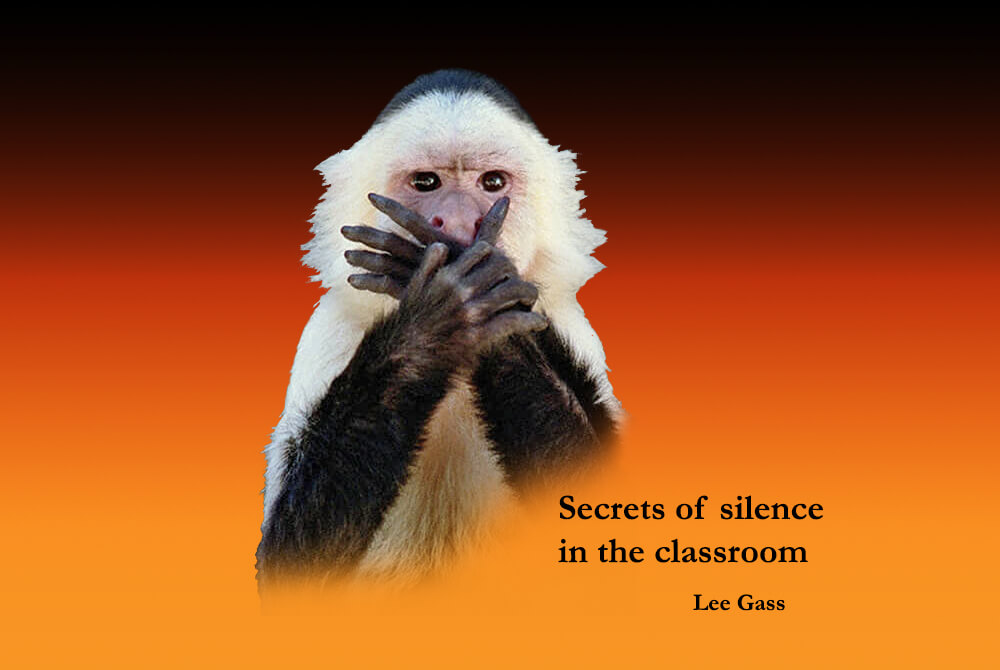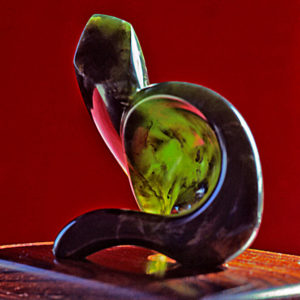Interviewing me
for my first teaching job,
at a high school, Ernie Wutzke, the
Principal, took me to visit the room of
Art, the biology teacher I would replace
if I got the job. He said it was impossible
to predict what would happen in
Art’s classroom, and made it
clear he thought that a
very good thing.
When we entered
the room, three students were
at the blackboard arguing about details
of photosynthesis or DNA and the rest of
the class was fully engaged in the discussion.
Art was on his back, on a high workbench
along the window, a book for a pillow,
apparently asleep.
Ernie and I
stood at the back of the room
while the argument raged, with
no sign of life from Art.
After a while
the discussion took a turn,
as arguments tend to do, toward
the personal. “That’s stupid!”, a student
exclaimed, others responded in kind, and
it escalated. After letting it go for a while,
Art stretched, rolled slowly and silently,
but theatrically, onto his side on the bench,
propped up his sleepy head with his fore-
arm, and everyone in the room stopped
and looked at him, listening but
not yet hearing anything.
They knew what he was going to say!
After what
seemed like forever,
Art commented that while
at the beginning of the discussion
everyone had been listening carefully to
everyone else and learning from it, he didn’t
think anyone was listening anymore. “You might
learn more if you listened to each other instead of
trying to prove how much you know”, and he
rolled back into his napping position,
went back to sleep, and the
discussion continued.
Ernie winked
at me and we left
the room.
He said Art
was the best teacher he’d
ever known, but in all the time he’d
worked there, Ernie had never once
actually caught him teaching.
More than any of the
other teachers he’d known, Art
tried new things, some of which
flopped badly and he
learned from
that.
“But if
you’re a tenth as
good as he is“, Ernie said,
nailing me in the eye
with his own,
“you’ll be
great.“
I never
actually met Art, but
for the last 56 years he’s been a
hero of mine and an influential mentor.
During those few minutes in Art’s class-
room, I learned one of the most valuable
lessons of my entire teaching career:
The less I teach them, the
more they learn.
Teaching in the
same room the next fall, I
saw how difficult it was to keep
my mouth shut and allow students
to explore ideas on their own
without my needing to
profess to them.
Eventually I
realized that it was easier to keep
my mouth shut when my hands were busy,
so I carved small sculptures in chalk in class
with my pocket knife. At the end of class as
I congratulated them on a job well done,
I presented tiny sculptures to students
who had contributed significantly
that day, and taxpayers footed
the bill for the artwork.
After a month or
so of my doing this, carving
had become much more than a cheap trick
to help me keep my mouth shut. It was a symbol,
a signal, a trigger, a ritual, and an important
component of our classroom culture that
grew more effective the more
we practiced it
together.
The more
students practiced talking
with each other and the more I
practiced staying out of their way,
the more they learned, the more
I learned, and the more
we all enjoyed the
process.
As if by magic,
the simple act of taking out
my knife, beginning to carve, and
keeping my mouth shut impelled
students to discuss things
deeply with each
other.
Teachers are like
Pavlov’s dog salivating when Pavlov
rang the bell. When students elicit teaching
behaviour in us, we teach. Teaching’s not
all we can do, though. We can also
elicit learning behaviour
right back at them.
Fortunately,
students are like Pavlov’s
dog about learning from and
with each other, so it
happens easily
if we let
it.
We
now know that
interactive engagement among
students is the #1 most significant factor
in development of conceptual understanding and
problem-solving ability, at least by under-
graduate science students.
Given the
universal compulsion of professors
at all levels to profess, it follows that we must
learn to remain silent in our classrooms. In
the various ways it emerged in my career,
the cheap trick of carving chalk
in class served me well
for decades.
(Can teachers even carry knives anymore?)
Later, at the
university level, I peeled the skins
of fruits and vegetables slowly and contemplatively
with my pocket knife as students filed into class. Listening
carefully to relaxed conversation as students came
in and speaking mainly in response to direct invi-
tation, I slowly nibbled on peels until it
was time to get to work.
That was
a first-year university
biology course for racial minority
students in 1969. Triggered often by my choice
of fare for the day, sessions began with a short
discussion of the skins of things. You can
imagine the variety of examples
available. It’s huge.
Given the
racial tensions of the time,
some of those discussions were
hilarious, depending on little more
than what I happened to be peeling
that day and whatever students had
to say about it. It loosened us up
for the work we were there
to do together.
Back
in high school teaching,
I sketched students in notebooks
and gave them what I’d drawn. I exam-
ined snakes in snake cages along the window,
gazed out the window, watched 60 sealed gallon
jar aquatic ecosystems on shelves in the window
struggling to survive. I studied architecture
I’d studied dozens of times before
and watched clouds move
up in the sky.
I don’t know
about you, but for me
it’s hard work sometimes to
not teach, or preach, or
whatever you want
to call it.
Art
pretended to take
a nap. Maybe he did nap; I don’t
know. Maybe he set some special sort of
alarm to alert him when his students
needed him to intervene.
As a
university
professor later, I took
small stone sculptures with me
to classes, committee meetings, office
hours,
and PhD exams, and sanded them
quietly and unobtrusively while
participating fully in dis-
cussions. This went
on for years.
People came
surprisingly quickly to expect
it from me, and no one complained.
Then, again rather easily, they
ignored it and attended to
the business at
hand.
Here are two
of those early sculptures,
Beast, in jade, and Flight from the
Island, in rhodonite. Each is between 1 1/2
and 2 inches high, not counting their bases.
They are tiny, and I sanded both of them
in meetings and classes.
Beast was
a graduation gift for a
student in my first-year biology class
who had worked in my hummingbird lab until
she graduated. We published her honours thesis
work. Zena Tooze later studied wolves for her
MSc, then founded and directed a primate
rehabilitation centre in Nigeria,
Cercopan.
Beast.
Jade, cocobolo.
Photo by Lee Gass.
Flight from the Island.
Rhodonite, slate.
Photo by Stuart Dee.
By a similar
token, meetings with obsessive
note-takers were much more effective
when we conducted them outside, walking
briskly through whatever the weather was at
the time. Note-takers rarely listen as well as
they could anyway, so walking while
talking helped them listen.
Many people
in universities, faculty and
students, are infected with the DISEASE
of note-taking, in fact. That turned my
office hours into opportunities
to exercise.
Walking while
talking and talking while
walking kept us breathing, kept
us thinking and feeling and
cleared the air for us
to listen.
We need to keep
breathing to keep walking.
That keeps us saving up air, keeps us
listening, and we don’t say anything until
we have something worth saying. It
makes it possible, really, for
us to converse with
each other.
When Maria Klawe
became Vice President at UBC,
we discovered she did something similar
to my sanding and chalk-carving “thing” in
meetings and classes. Maria painted water-
colours in meetings, even Board of Directors’
meetings and meetings with ‘suits’ downtown.
Now, as President of Harvey Mudd College,
renowned mathematician and computer
scientist, she still does. In two wonder-
ful videos, Maria discusses that
practice and gives
examples.
Maria gave me
a painting of a male rufous
hummingbird for my 60th birthday
and it hangs in our home today.
I hope she painted it in a
Board meeting.
Male rufous hummingbird and flowers.
Watercolour painting
by Maria Klawe.
Keeping your
mouth shut while you teach
is not rocket science, people!
And it’s a no-brainer
once you think
about it.
Get over it.
It’s not our job to teach
our students. Our job is for
our students to learn, which is a
different breed of cat than
teaching them.
Once the
magic starts, all we have
to do is shut up, stand back, step
out of the way, and let it happen. We
usually have to stir up some kind of trouble
to get things going and intervene some-
times to guide it, like Art did with
his teenagers.
But we
don’t, can’t, and
should not even try to
“make” it happen. The magic
happens by itself.
As far as I’ve
been able to tell, that’s
how creativity works. I’ve said
what I mean by creativity in
other stories. I’ve also said
students must do that
part for themselves.
It’s often easier
for them to do it in groups,
but they have to do it
themselves.
Not just students,
either. Everyone. Overwhelmingly,
my experience has been that students are more
than happy to learn creatively, as long as
their social environments encourage
rather than discourage
that.
It sure beats memorizing stuff!
It
beats reading
what memorizers memorize,
too! Can you imagine reading that
all your life? What a drag and a lot
of work for so little gain! it’s a
perfect lose-lose situation
for everyone!
Not only
did I not want to waste my
own time doing that. I didn’t want my
students to waste theirs memorizing. What
an insight it was for me to realize that I
didn’t need to test what they knew
to know what they knew.
If I tested for
understanding and expected
them to use knowledge to demonstrate
it, I’d get both. If they don’t understand what
they know they can’t use it, regardless of
what they know, so I had to
teach for under-
standing.
But
I had to shut up
every once in a while
and let it happen!
I often
tell the story about Art
in talks. Though I think I called Art
Al in one of them, here are two examples.
Stories about Stories and Making Magic Together.
An earlier version
of this story is in the book
Silences in Teaching and Learning
Here is a review of a reading
from that book.
When Gary Poole came
to UBC to direct our Teaching
and Learning Centre, he and I talked a
lot about our dreams for the future and how
to collaborate to make them real. We usually
did this practically at a dead run. Across
campus, down the road to English Bay,
along the beach trail and part way
back, up the cliff on a steep
trail, and back to our
offices for the rest
of the day.
If either of us
had something hot and
burning to say on the way up
the cliff but couldn’t say it for lack of
air, we stopped as briefly as possible
to get us going again, still out of
breath but able to speak
and listen.
In telling
others about those meetings,
Gary referred to my style of communicating,
punningly, as “running meetings”. I think he was
daring them to meet with me, and many of them
took him up on it. It was great exercise while
it lasted. Now I get exercise
in other ways.
Conducting Running Meetings
A brief, two-stanza operating manual.
Conducting
running meetings is both an
art and a subtle skill. So much depends
on conditioning that breathing rate, which
you easily hear, is a reliable indicator of
how any given meeting is going at
any given moment on any
given walk.
As walking
speed increases, so do meta-
bolism and rate and depth of breathing.
Talking competes with walking for oxygen,
so you can gently push breathing rate high
enough to favour listening over speaking,
then slow or even stop so your comm-
unicants can speak and you
can listen.
Often when
Gary Poole and I
charged up the hill, our
talks reached a crescendo near
the top of a steep, punishing trail up
to the plateau, just when we were most
out of breath, most in oxygen debt,
and most aware of the pain
of Lactate Burn.
Ideas churned
faster than either of us could
have articulated but neither of us could
talk about anything. But we remembered,
talked when we could talk, and applied
some significant fraction of those
ideas in our work.
The Institute
for the Scholarship of Teaching
and Learning grew out of a walk
and a talk like that.
Gary Poole
and I having brainstorms
near the top of a steep climb when
we were out of oxygen reminds me of
Luis Sobrino’s response when I asked
him in Science One class one day
where he, a theoretical physicist,
got his best ideas.
Instantaneously,
Luis said ‘On the bicycle.’
When I grilled him
further about it, he told us about
his daily ride from home on a boat in False
Creek, through Jericho Beach and Spanish Banks
parks to the bottom of the hill up to UBC. It’s the same
hill as before, but more gently on a road and sidewalk
instead of a steep trail and biking instead of huffing
up a trail, less than a kilometer from where
had our own epiphanies.
Every morning,
rain, shine, snow or ice, Luis
stashed his bike in the bushes, stripped
off all his clothes, and swam in the ocean
before riding up the hill to his office in the
physics building. His best ideas came
a little lower on the hill than ours,
near a tree where an eagle
perched sometimes
on my own rides
up the road.
For what
happened to my
consciousness near the bottom
of a steep descent, see Lactate Burn.
Edited May 2022





